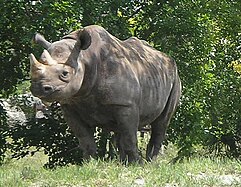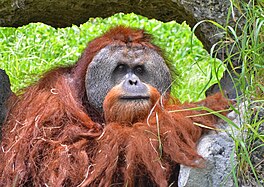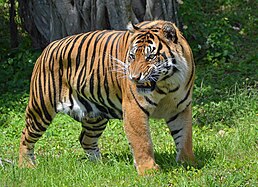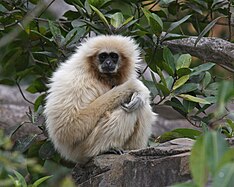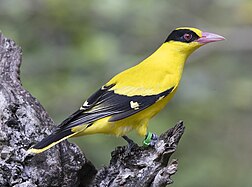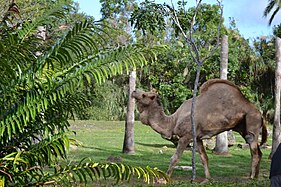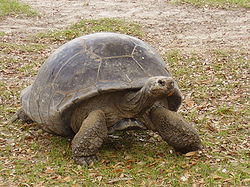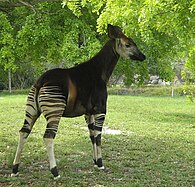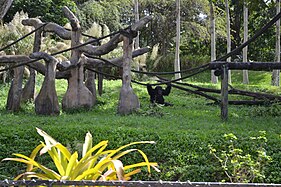Zoo Miami
| Zoo Miami | |
|---|---|
 | |
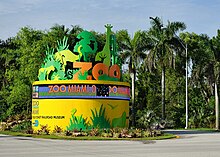 Entrance fromState Road 992. | |
 | |
| Date opened | 1948(Crandon Park Zoo) July 4, 1980(Miami MetroZoo)[1] |
| Location | Miami-Dade County,Florida,United States |
| Land area | 750 acres (304 ha) (324 acres (131 ha) developed)[2] |
| No.of animals | 3,000[2] |
| No.of species | 500[2] |
| Annual visitors | 1+ million[3] |
| Memberships | Association of Zoos and Aquariums |
| Major exhibits | 100[2] |
| Website | www |
TheMiami-Dade Zoological Park and Gardens,also known asZoo Miami,is azoological park and gardeninMiamiand is the largestzooinFlorida.Originally established in 1948 atCrandon ParkinKey Biscayne,Zoo Miami relocated in 1980 asMiami MetroZooto the former location of theNaval Air Station Richmond,[4]southwest of Miami in southernunincorporatedMiami-Dade County,[5]surrounded by thecensus-designated placesofThree Lakes(north),South Miami Heights(south),Palmetto Estates(east) andRichmond West(west).
The onlytropicalzoo in the continentalUnited States,Zoo Miami houses over 3,000 animals of around 500 species on almost 750 acres (304 ha), 324 acres (131 ha) of which are developed. It is 4 mi (6 km) around if walked on the path, and features over 100 exhibits.[2]The zoo's communications director is zookeeperRon Magill.[6]Zoo Miami is accredited by theAssociation of Zoos and Aquariums(AZA).
History[edit]
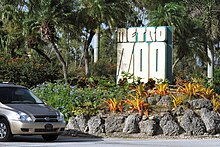
The history of Zoo Miami can be traced back to 1948, when a small road show, stranded near Miami, exchanged three monkeys, a goat and two black bears for approximately $270 in repairs for the truck.[7]These six animals were the beginning of theCrandon Park ZooatCrandon Parkon the island ofKey Biscayne,just southeast off the coast fromdowntown Miami.[2]The Crandon Park Zoo occupied 48 acres (19.4 ha) of the park. The first animals in the zoo, including some lions, an elephant and a rhinoceros, had been stranded when a circus went out of business in Miami. Some Galapagos tortoises, monkeys and pheasants were added from the Matheson plantation.[8]By 1967, the Crandon Park Zoo had grown to over 1,200 animals, and was considered one of the top 25 zoos in the country.[9] Other animals were added, including a white Bengal tiger in 1968.
In 1965,Hurricane Betsydevastated the zoo and killed 250 animals. After the hurricane, there was talk of a new zoo for Dade County, but not until 11 December 1970 did Dade County officials apply for 600 acres (243 ha) of land in theNaval Air Station Richmondproperty. Construction began in 1975. The zoo opened on July 4, 1980,[1]asMiami MetroZoo,with a preview section of 12 exhibits;Asia,the first major exhibit, opened on December 12, 1981. A total of 38 exhibits, covering 200 acres (81 ha), were open to the public at this time.[2]
In the 1980s, the zoo continued to expand. An additional 25 acres (10 ha), with six new African hoofed-mammal exhibits, opened in 1982, along with the zoo'smonorailin 1984. After the closing of the1984 Louisiana World ExpositioninNew Orleans,the expo’s visitor monorails were moved to Florida to be re-purposed at Miami MetroZoo and operated until 2022.[10][11]Wings of Asia,a 1.6-acre (0.6 ha) free-flightaviary,was opened in December 1984. Three additional African hoofed stock exhibits followed in 1985, and two new exhibits were opened in the African savanna section in 1986. The Australian section of the zoo was opened in 1989, andPAWS,the children's petting zoo, opened in 1989.[2]TheAsian Riverlife Experienceopened in August 1990.
In 1992, the zoo suffered extensive damage whenHurricane Andrewmade landfall in South Florida, on August 24. The small, yet intensely powerfulcategory 5 hurricanetoppled over 5,000 trees and destroyed theWings of Asiaaviary (which had been built to withstand winds of up to 120 miles per hour (193 km/h)) resulting in the loss of approximately 100 of the 300 resident birds.[12]Despite the majority of the zoo's animals remaining outside during the duration and aftermath of Hurricane Andrew, only five animals were killed from either debris or the consumption of contaminated water. MetroZoo, though looking dramatically different, reopened on December 18, 1992, with the zoo's tiger temple exhibit renamed in honor of Naomi Browning, a local 12-year-old zoo volunteer who was one of the storm's casualties.
By July 1993, many of the animals that were sent to other zoos and animal parks across the United States (during the zoo's reconstruction) had been returned to Miami, and over 7,000 new trees had been planted to begin restoring the zoo'stree canopy.[13]
In 1994, stray dogs entered the zoo during off-hours, and killed fiveThomson's gazellesand twoGrant's gazelles.[14]

In 1996, abrush fireburned 100 acres in the southeast portion of the zoo's undeveloped land.[14]Nearly 30 animals from adjacent exhibits were evacuated.[15]TheFalcon Batchelor Komodo Dragon Encounteropened that same year, followed by exhibits featuringAndean condors(1999),meerkats(2000),Cuban crocodilesandsquirrel monkeys(2001).Dr. Wilde's World,which is an indoor facility for traveling zoological exhibits, was also opened in 2001. The rebuiltWings of Asiaaviary, housing more than 300 individual birds and representing 70 species, refurbished in the spring of 2003.

On July 4, 2010, the zoo was renamed theMiami-Dade Zoological Park and Gardens,orZoo Miami(for marketing and branding purposes). This was a part of the zoo's 30th anniversary celebration.[1][16]The zoo broke ground on a $43 million project that included anEvergladesexhibit and a new state-of-the-art entryway.[17]The Everglades exhibit opened on December 10, 2016.
In 2017, the zoo was struck byHurricane Irma,which impacted South Florida on September 10. TheAmazon and Beyondexhibit suffered the most damage, with widespread tree loss in that area. According to the zoo, oneAmerican flamingo,oneGreat hornbill,and a few other birds died reportedly due to stress.[18]The zoo remained closed until October.[19]
In May 2023, footage of akiwinamed Paora at Zoo Miami being handled by visitors and exposed to daylight caused outrage amongst New Zealanders andconservationexperts, including Paora Haitana for whom the bird is named. The New ZealandDepartment of Conservationstated they would raise their concerns with the AZA.[20][21][22][23]Zoo Miami subsequently apologized and said it would cease these practices.[24]
Conservation efforts[edit]
Zoo Miamisupports conservation programs at the local, national and global level, and was a founding member of theAZA's Butterfly Conservation Initiative (BFCI), a program designed to assemble governmental and non-governmental agencies to aid in the population recovery of vulnerable, threatened and endangered butterflies inNorth America.[citation needed]
The zoo has also provided financial help through the Zoo Miami Conservation Fund to upgrade captive-breeding facilities inThailand’s zoos, notably for endangeredclouded leopardsandfishing cats.[25]
Exhibits and animals[edit]

There are five main exhibit sections in the zoo: Florida: Mission Everglades, Asia, Africa, Amazon and Beyond, and Australia. The zoo's main entry includes an entryway canopy structure, conjoining ticket booths and gift shop, and an adjacentAmerican flamingoexhibit.[17]At the junction of the zoo's main pathways, is the Conservation Action Center, an indoor pavilion featuring interactive exhibits themed toconservationandwildlife preservation.The property includes a large lake, called Lake Iguana. Zoo Miami is characterized by large cage-less,moatedexhibits.
From 1984 until 2022, anair-conditionedmonorailsystem traveled around the zoo's premises, providing both an aerial view of the zoo and a convenient way to move between sections.[11]The monorail system had four stations throughout the zoo. Narratedtramrides andguided tourswere given daily. The monorail was decommissioned due to unaffordable maintenance costs. There were 5 trains in total, 3 of which were formerly used for theNew Orleans World's Fair.One train was decommissioned in 1987 so that it could be used for parts for the others, as the manufacturer ceased business.
Florida: Mission Everglades[edit]

The Florida: Mission Everglades exhibit features native fauna and flora species found inFlorida,particularly from the state'sEvergladesregion.[26]Species displayed includeAmerican alligators,American crocodiles,North American river otters,American black bears,Florida panthers,bald eagles,brown pelicans,androseate spoonbills.The $33 million project features Lostman's River Ride, a gentleairboatride attraction.
Asia[edit]
The zoo's Asian exhibit features dozens of animals such asBornean orangutans,Asian elephants,Indian rhinoceros,Sumatran tigers,gaurs,bantengs,lowland anoas,Arabian oryx,Bactrian camels,dromedary camels,Malayan tapirs,sloth bears,northern white-cheeked gibbons,siamang,as well as a variety of Asian birds. The now-defunct Asian River Life Experience replicated the appearance of an Asian river brook. Until 2023, Zoo Miami was only one of two zoos in the United States to display a pair ofblack-necked storks.[27]Several species not native to Asia are also found in this area likelions,African painted dogs,spotted hyenas,okapis,addax,sable antelope,addra gazelles,mongoose lemur,andCuban crocodiles.
The American Banker's Family Aviary, Wings of Asia is a walkthrough aviary that's home to approximately 85 species of birds.

Bird Species List:
- Buff-banded rail
- Masked lapwing
- Nicobar pigeon
- Red-knobbed imperial pigeon
- Pied imperial pigeon
- Victoria crowned pigeon
- Mindanao bleeding-heart
- Luzon bleeding-heart
- Crested pigeon
- Pheasant pigeon
- Chestnut-breasted malkoha
- Oriental dollarbird
- Red-vented bulbul
- White-eared bulbul
- Black bulbul
- Black-throated laughingthrush
- White-crested laughingthrush
- Metallic starling
- Black-collared starling
- White-breasted woodswallow
- Black-naped oriole
- White-eared catbird
- Fawn-breasted bowerbird
- Azure-winged magpie
- Javan pond heron
- Painted stork
- White stork
- Straw-necked ibis
- Magpie goose
- Bar-headed goose
- Red-breasted goose
- Spotted whistling duck
- Mandarin duck
- Indian spot-billed duck
- Australian shoveler
- Marbled teal
- Falcated duck
- Tufted duck
- Scaly-sided merganser
- White-winged duck
- Ruddy shelduck
- Great argus
- Germain's peacock-pheasant
- Edward's pheasant
- Green junglefowl
- Green peafowl
- Sarus crane
- Grey-headed swamphen
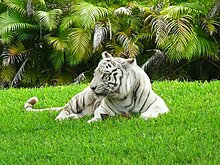
The zoo'sorangutanexhibit once housedNonja,a femaleSumatran orangutanthat was relocated from aDutchzoo to Zoo Miami. She was widely believed to be the oldest living specimen of her species, until her death in 2007.[28]Another notable resident was Carlita, a 21-year-old femalewhite Bengal tiger,who resided in the zoo's tiger enclosure from 1994 until her death in 2013.[29][30]
The Asian exhibit is home to two Asian elephants: an elderly female named Nellie and a young male named Ongard. Dalip (a bull born on June 8, 1966, inKerela), arrived at the old Crandon Park Zoo on Key Biscayne as a young calf in August 1967, along with his mate Seetna and he is the father to Spike (born on July 2, 1981, in Zoo Miami and he is Dalip's only surviving offspring) who currently lives in the Smithsonian National Zoo in Washington. Seetena and Dalip were separated due to the damage caused by Hurricane Andrew in 1992. Both were separated during the storm, Seetna moved to Two Tails Ranch (Patricia Zerbini) and stayed there for breeding purposes but died of labor issues in 1996 while Dalip returned to Zoo Miami in 1995 where he remained until his death in 2022.[31]
The American Banker's Family Aviary, Wings of Asia is also located here. The aviary features 300 rare birds of 70 species in atemperate mixed forest,and it highlights the evolutionary connection of birds todinosaurs.At 54,000 square feet (5,017 m2), it is the largest open-air Asian aviary in theWestern Hemisphere.[32]The Children's Zoo[33]hosts animals that can be approached to a close distance by guests. Guests can viewmeerkats,apetting zoo,an exhibit that displays small species of reptiles, amphibians and insects, butterfly gardens, acarouseldedicated to individual animal species, and experience traditionalcamelrides.
Africa[edit]

The African loop of the zoo offers animals from different locations onAfrica.Visitors can observe species includingreticulated giraffes,pygmy hippos,African bush elephants,eastern black rhinoceroses,greater kudus,nyalas,slender-horned gazelles,Grevy's zebras,giant elands,chimpanzees,western lowland gorillas,mountain bongo,yellow-backed duikers,okapis,andservals.Oasis Grill, a small eatery plaza, is situated at the northern end of the African exhibits. Zoo Miami has one of the most diverse collections of hoofed stock in the United States.[34]
Eleven-year-old "Pongo," at sixteen feet the tallest giraffe in the zoo, was euthanized on January 4, 2021, after failing to recover from a foot injury.[35]
Amazon and Beyond[edit]

Amazon and Beyond, situated in the zoo's northwest corner, opened on December 6, 2008 and is a collection of South America animals. This area has 27 acres (10.9 ha) dedicated to thefloraandfaunaofSouth America,and is subdivided into four distinct areas: Village Plaza, Cloud Forest, Amazon Flooded Forest, and Atlantic Forest. Three areas represent native habitats that are found in theAmazonianregion—the "cloud forest",theAmazon Riverbasin, and theAtlantic Forest-Pantanal—with species such asgiant otters,jaguars,Orinoco crocodiles,giant anteaters,black howler monkeys,black-handed spider monkeys,Hoffmann's two-toed sloths,harpy eagles,fruit bats,poison dart frogs,and various Amazonian fish.[36]
Australia[edit]
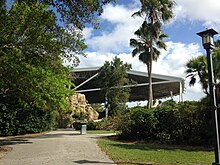
The zoo's Australian habitat showcases specimens from throughout the region ofAustralia,Oceania,and thePacific islands,includingkoalas,southern cassowaries,southern hairy-nosed wombats,cockatiels,andMatschie's tree-kangaroos.Situated near this to habitat, is the 800-seat Sami Family Amphitheater, where daily animal presentations, concerts and cultural events are held.
Theamphitheateris named in memory of Albert and Winifred Sami, who anonymously donated an estimated $3 million to the zoo from 1993 until their deaths in 2007 and 2014, respectively.[37]Zoo Miami recently celebrated the birth of a baby koala, who was actually born in May, 2019, but only emerged from its mothers pouch on January 8, 2020. The baby koala was named Hope in light of the recent fires that devastated Australia.[38]
Near the Australian habitat is a trail withGalapagos giant tortoises,babirusas,red river hogs,common warthogs,andVisayan warty pigs.
Gallery[edit]
-
African elephantat the zoo
-
American flamingos(Phoenicopterus ruber)
-
Orangutan at the zoo
-
Sumatran tiger(Panthera tigris sondaica)
-
Lar gibbon(Hylobates lar)
-
Black-naped oriole(Oriolus chinensis)
-
Camel
-
Tortoise
-
Rosa 'Miami Moon', one of the many flowering plants at the zoo
-
Giraffe
-
White Tiger
Zoo Miami Foundation[edit]
Zoo Miami Foundation is the 501(c)(3) nonprofit support organization of Zoo Miami. It was founded in 1956 and is responsible for educational programming and capital improvements at the zoo over the years. They are rated as a 4* charity by Charity Navigator (https:// charitynavigator.org/ein/596192814) and were awarded the Platinum Seal of Transparency by Guidestar (https:// zoomiami.org/about-zoo-miami-foundation)
See also[edit]
- Gold Coast Railroad Museum(adjacent to Zoo Miami)
- Nonja (Malaysian orangutan)
- Rosie the Elephant
References[edit]
- ^abc"Renaming of Miami MetroZoo".miamidade.gov.Miami-Dade County.Retrieved23 June2010.
- ^abcdefgh"About Zoo Miami: Keepin' it wild since 1948".Zoo Miami.RetrievedMay 20,2015.
- ^Castelblanco, Cindy."Zoo Miami breaks attendance mark, welcomes over 1M guests in 2021".Miami's Community Newspapers. Kendall Gazette.
- ^Destroyed Richmond Naval Air Station
- ^"2020 CENSUS - CENSUS BLOCK MAP: Miami-Dade County, FL"(PDF).U.S. Census Bureau.p. 62 (PDF p. 63/154).Retrieved2022-08-13.
- ^Hanks, Douglas (April 30, 2015)."The face of Zoo Miami enjoys a star turn in Havana".Miami Herald.RetrievedMay 20,2015.
- ^"Zoo Miami".SOMI Magazine.12(4): 15. April–May 2017.
- ^Blank, Joan Gill. 1996. HIKey Biscayne.Sarasota, Florida: Pineapple Press, Inc.ISBN1-56164-096-4.pp. 158-160, 163-164.
- ^Abraham, Kristin (28 January 2010)."Visiting Zoo Miami".miamibeachadvisor.Miami Beach Advisor.Retrieved28 June2010.
- ^Cotter, Bill,The 1984 New Orleans World's Fair,Arcadia Publishing, Charleston, South Carolina, 2008, p.120.ISBN0-7385-6856-2
- ^abGarcia, Amanda Batchelor, Annaliese (2022-04-01)."Zoo Miami's monorail takes its final ride".WPLG.Retrieved2022-04-02.
{{cite web}}:CS1 maint: multiple names: authors list (link) - ^Abbady, Tal (1992)."Miami's zoo teems with new life 10 years after Hurricane Andrew".The Sun-Sentinel.RetrievedMay 21,2015.
- ^Lohr, Steve (May 21, 2015)."AFTER THE STORMS: THREE REPORTS; Miami".The New York Times.RetrievedMay 21,2015.
- ^abSan Martin, Nancy (March 24, 1996)."Animals Unharmed As Fire Consumes 100 Acres At Zoo".The Sun-Sentinel.RetrievedMay 24,2015.
- ^"Fire Erupts Near Zoo; Animals Evacuated".Los Angeles Times.Times Wire Services. March 24, 1996.RetrievedMay 24,2015.
- ^"Miami MetroZoo Celebrates its 30th Birthday with a New Name".miamimetrozoo.Miami Zoo.Retrieved28 June2010.
- ^abMorejon, Liane (May 7, 2014)."Groundbreaking ceremony held at Zoo Miami for Mission Everglades exhibit".Local 10 News.RetrievedMay 21,2015.
- ^Herrera, Chabeli (September 13, 2017)."South Florida's attractions suffered severe damage during Irma. But most animals survived".Miami Herald.RetrievedSeptember 28,2017.
- ^Herrera, Chabeli (September 25, 2017)."Tourism industry to visitors: Don't #prayforMiami. We're fine".Miami Herald.RetrievedSeptember 28,2017.
- ^Marriner, Chris (May 23, 2023)."Miami Zoo's treatment of Paora the kiwi sparks petition".New Zealand Herald.
- ^Anderson, Ryan; Dunseath, Finlay (May 23, 2023)."DOC to raise concerns with Miami Zoo over treatment of kiwi".Stuff.
- ^Ternouth, Louise (May 23, 2023)."Paora Haitana concerned at treatment of namesake kiwi at Miami Zoo".RNZ.
- ^Wilton, Perry (May 23, 2023)."Conservation specialist slams viral kiwi video at Miami zoo as DoC raises concerns".Newshub.
- ^Anderson, Ryan (May 24, 2023)."Miami zoo to stop mistreatment of kiwi after concerns raised over welfare".Stuff.
- ^"Zoo Miami Conservation: Asian Projects".miamimetrozoo.co.Zoo Miami.Retrieved13 July2010.
- ^Staletovich, Jenny (December 2, 2016)."Zoo Miami's mission: to make sure the zoo isn't the last place you see these animals".Miami Herald.RetrievedDecember 6,2016.
- ^Torres, Andrea (August 4, 2023)."Zoo Miami's last black-necked stork dies".local10.RetrievedAugust 5,2023.
- ^"'World's oldest' orang-utan dies ".BBC News.BBC.2002-12-31.Retrieved2012-03-17.
- ^Dixon, Lance (September 16, 2014)."Iconic Zoo Miami white tiger euthanized".Miami Herald.RetrievedMay 21,2015.
- ^Martin, Vanessa (September 19, 2014)."Carlita Dead: White Bengal Tiger Dies At Zoo Miami".The Huffington Post.RetrievedMay 21,2015.
- ^Hanks, Douglas (November 24, 2022)."Dalip, a Miami zoo elephant since the 1960s and one of the nation's oldest, dies at 56".Miami Herald.RetrievedJuly 12,2023.
- ^"Wings of Asia".Zoo Miami.RetrievedMay 20,2015.
- ^"Children's Zoo".Zoo Miami.RetrievedMay 20,2015.
- ^"Zoo Miami".Trip Advisor.
- ^Teproff, Carli (January 4, 2021)."Pongo was the tallest giraffe at Zoo Miami. A fractured foot has led to a sad goodbye".news.yahoo.Miami Herald.RetrievedJanuary 5,2021.
- ^"Amazon and Beyond Exhibit".Zoo Miami.RetrievedMay 20,2015.
- ^Ron Magill; Dan LeBatard (August 14, 2014)."Zoo Miami's Ron Magill reveals identity of long-anonymous donors of millions".Miami Herald.RetrievedMay 20,2015.
- ^"South Florida zoo celebrates birth of baby koala".FOX 13 News.2020-01-09.Retrieved2020-01-24.
External links[edit]
- 1948 establishments in Florida
- Aviaries in the United States
- Botanical gardens in Florida
- Buildings and structures in Miami-Dade County, Florida
- Education in Miami-Dade County, Florida
- Parks in Miami-Dade County, Florida
- History of Miami-Dade County, Florida
- Tourist attractions in Miami-Dade County, Florida
- Educational organizations established in 1948
- Zoos established in the 1940s
- Zoos in Florida
- Monorails in the United States



